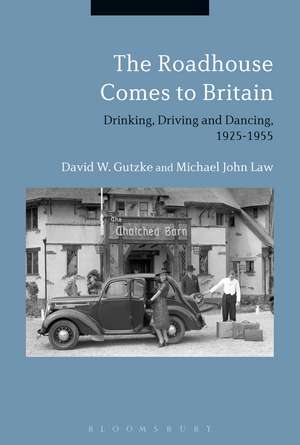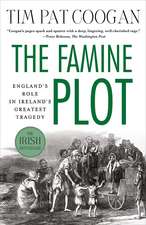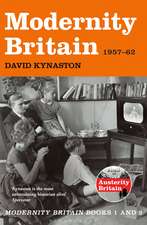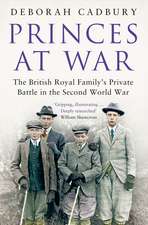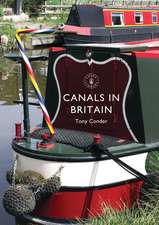The Roadhouse Comes to Britain: Drinking, Driving and Dancing, 1925-1955
Autor David W. Gutzke, Dr. Michael John Lawen Limba Engleză Hardback – 19 apr 2017
| Toate formatele și edițiile | Preț | Express |
|---|---|---|
| Paperback (1) | 237.28 lei 6-8 săpt. | |
| Bloomsbury Publishing – 31 oct 2018 | 237.28 lei 6-8 săpt. | |
| Hardback (1) | 772.58 lei 3-5 săpt. | |
| Bloomsbury Publishing – 19 apr 2017 | 772.58 lei 3-5 săpt. |
Preț: 772.58 lei
Preț vechi: 1112.22 lei
-31% Nou
Puncte Express: 1159
Preț estimativ în valută:
147.84€ • 158.08$ • 123.26£
147.84€ • 158.08$ • 123.26£
Carte disponibilă
Livrare economică 28 martie-11 aprilie
Preluare comenzi: 021 569.72.76
Specificații
ISBN-13: 9781474294508
ISBN-10: 1474294502
Pagini: 192
Ilustrații: 20 bw illus
Dimensiuni: 156 x 234 x 23 mm
Greutate: 0.45 kg
Editura: Bloomsbury Publishing
Colecția Bloomsbury Academic
Locul publicării:London, United Kingdom
ISBN-10: 1474294502
Pagini: 192
Ilustrații: 20 bw illus
Dimensiuni: 156 x 234 x 23 mm
Greutate: 0.45 kg
Editura: Bloomsbury Publishing
Colecția Bloomsbury Academic
Locul publicării:London, United Kingdom
Caracteristici
A full exposition of the roadhouse phenomenon and its relationship with competing leisure activities, set in an Anglo-American context
Notă biografică
Michael John Law is Research Fellow in History at the University of Westminster, UK. He is the author of The Experience of Suburban Modernity: How Private Transport Changed Interwar London (2014).David W. Gutzke is Professor of History at Missouri State University, USA. His most recently authored book is Women Drinking Out in Britain since the Early 20th Century (2014).
Cuprins
1. Introduction 2. Gaudy Shacks and Palaces 3. Transatlantic Trangressions4. Driving to the Roadhouse 5. Negotiating Class 6. Americanization and Modernity7. TThe Roadhouse in the Public Imagination 8. Death of the Roadhouse 9. Conclusion Appendix: Catalogue of Interwar British RoadhousesBibliography
Recenzii
An important, enlightening and racy book on a racy topic which demonstrates convincingly the link between Americanisation, class, fashion and fad in the age of the growth of motoring in Britain during the inter-war years. It should be read widely for both pleasure and academic interest.
One of the great strengths of the volume is the richness of the numerous illustrations and the use of novels, short stories, films, plays, roadhouse newsreels, and newspaper and magazine articles. The sources make this a compelling account of the short life of the roadhouse as well as a significant and overlooked part of interwar domestic tourism and the role of the car in the development of middle-class leisure. This is a highly readable volume that will be very useful in the classroom. The book will also appeal to a wide audience, including scholars of twentieth-century British and American popular culture.
This interesting and important study adds significantly to the historical and anthropological literature on alcohol and drinking spaces in society ... Roadhouses were so deeply ingrained in the romantic imagination of British high society during the interwar years that they helped define a generation. Summing Up: Highly recommended. All levels/libraries.
This fascinating book offers a vivid insight into a neglected subject of the interwar period.
This is a pioneering and fascinating book on the brief interwar moment in elite leisure. It is a well-conceived and well-researched imaginative definition of a topic that references the wealthy and adventurous Bright Young Things and their fast cars, as well as homosexuality, anti-Semitism, and black jazz musicians who bring back memories of Downton Abbey.
Motor-cars, society between the wars and ideas from American films came together to produce the English roadhouse, an altogether more exclusive place than the American version, though it always pretended to have a bit of the wickedness of defying Prohibition about it. The Roadhouse Comes to Britain brings together this mixture of frailties in an informed and informative way without losing any of the entertainment value of the story.
The interwar roadhouse has been shamefully neglected by historians, but now it has the scholarly attention it deserves. Both subversive and suburban, the roadhouse offered Americana, alcohol, music, petrol, and sex in the car park. Mellifluous in style and meticulous in detail, The Roadhouse Comes to Britain makes a major contribution to the social history of interwar Britain, and also shines new light into an earlier era of the night-time economy of London.
One of the great strengths of the volume is the richness of the numerous illustrations and the use of novels, short stories, films, plays, roadhouse newsreels, and newspaper and magazine articles. The sources make this a compelling account of the short life of the roadhouse as well as a significant and overlooked part of interwar domestic tourism and the role of the car in the development of middle-class leisure. This is a highly readable volume that will be very useful in the classroom. The book will also appeal to a wide audience, including scholars of twentieth-century British and American popular culture.
This interesting and important study adds significantly to the historical and anthropological literature on alcohol and drinking spaces in society ... Roadhouses were so deeply ingrained in the romantic imagination of British high society during the interwar years that they helped define a generation. Summing Up: Highly recommended. All levels/libraries.
This fascinating book offers a vivid insight into a neglected subject of the interwar period.
This is a pioneering and fascinating book on the brief interwar moment in elite leisure. It is a well-conceived and well-researched imaginative definition of a topic that references the wealthy and adventurous Bright Young Things and their fast cars, as well as homosexuality, anti-Semitism, and black jazz musicians who bring back memories of Downton Abbey.
Motor-cars, society between the wars and ideas from American films came together to produce the English roadhouse, an altogether more exclusive place than the American version, though it always pretended to have a bit of the wickedness of defying Prohibition about it. The Roadhouse Comes to Britain brings together this mixture of frailties in an informed and informative way without losing any of the entertainment value of the story.
The interwar roadhouse has been shamefully neglected by historians, but now it has the scholarly attention it deserves. Both subversive and suburban, the roadhouse offered Americana, alcohol, music, petrol, and sex in the car park. Mellifluous in style and meticulous in detail, The Roadhouse Comes to Britain makes a major contribution to the social history of interwar Britain, and also shines new light into an earlier era of the night-time economy of London.
